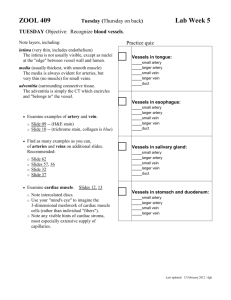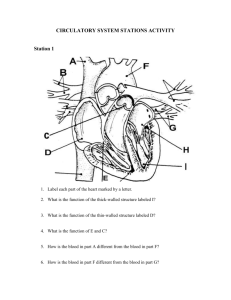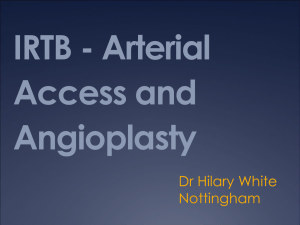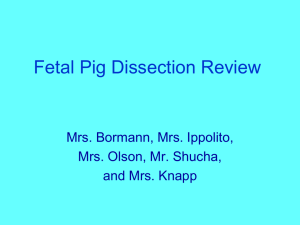Laboratory Outline for Biology 343
advertisement
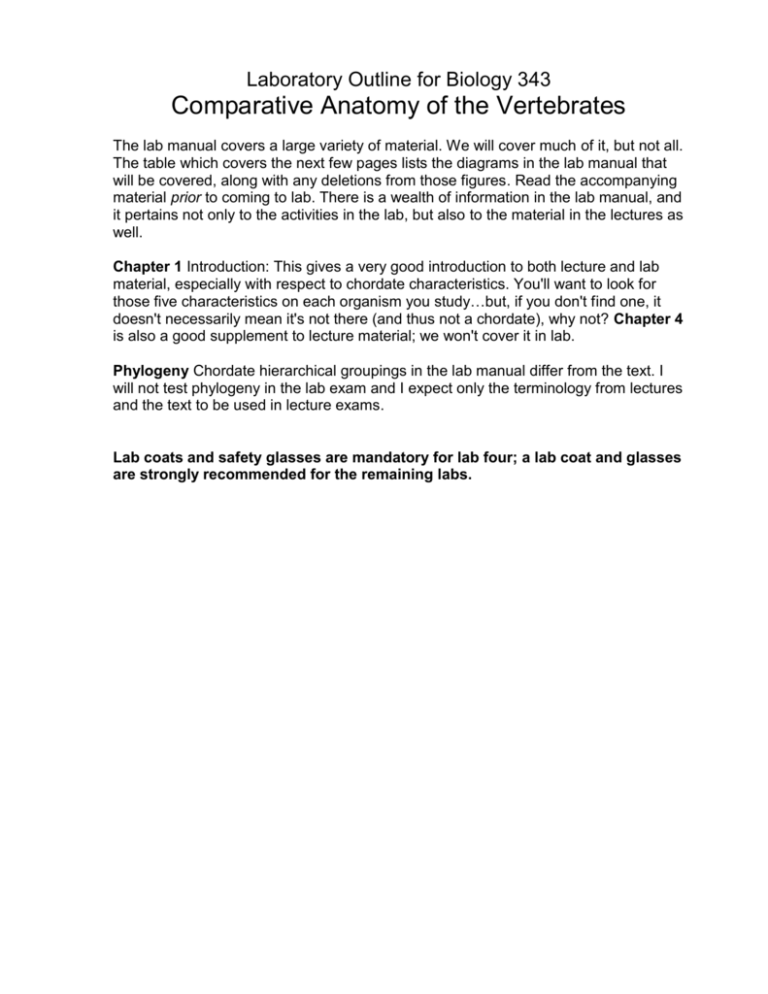
Laboratory Outline for Biology 343 Comparative Anatomy of the Vertebrates The lab manual covers a large variety of material. We will cover much of it, but not all. The table which covers the next few pages lists the diagrams in the lab manual that will be covered, along with any deletions from those figures. Read the accompanying material prior to coming to lab. There is a wealth of information in the lab manual, and it pertains not only to the activities in the lab, but also to the material in the lectures as well. Chapter 1 Introduction: This gives a very good introduction to both lecture and lab material, especially with respect to chordate characteristics. You'll want to look for those five characteristics on each organism you study…but, if you don't find one, it doesn't necessarily mean it's not there (and thus not a chordate), why not? Chapter 4 is also a good supplement to lecture material; we won't cover it in lab. Phylogeny Chordate hierarchical groupings in the lab manual differ from the text. I will not test phylogeny in the lab exam and I expect only the terminology from lectures and the text to be used in lecture exams. Lab coats and safety glasses are mandatory for lab four; a lab coat and glasses are strongly recommended for the remaining labs. 2 These are Deletions, unless otherwise specified. Figures that are not listed here will not be covered. Editions 3&4 5 Fig 2.2 a 2.2 b 2.5 a 2.7 a c c 2.6 a 2.5 a b b c cf 2.7 2.6 3.6 a b c branchial pouch/pore, collar + proboscis coeloms, stomochord nerve ring, collar nerve chord, trunk vnc, trunk dnc. cerebral ganglion heart, gonad, stomach keep all pigment spot keep all (users of the earlier editions will get a handout for figures d f) primary (septa); Secondary (tongue bar); accessory artery; coelom (both occurrences); dorsal aorta; skeletal rod; blood vessel. keep all keep all inferior (internal) jugular vein, velar tentacle; Is blood in the afferent branchial artery oxygenated or deoxygenated? 3rd and 4th – delete pleuroperitoneal cavity inferior jugular vein. Note some specimens may have ovaries instead of testes. 3.8 Try to picture blood flow in these blood vessels. Where is the blood going? Is it high or low in CO 2? The pattern is very similar to that of the dogfish. 3.10 change prosencephalon to brain; omit subpharyngeal gland Table 5.2 5.4, 5.5 5.7-5.10 5.12-5.14 5.16-5.17 Of wrists and ankles: 2 Deletions (unless otherwise specified) Commit these terms to memory! good references for lecture material and lab; keep all keep all, though omit 5.8 (a). keep all keep all For the purpose of this lab, the bones of the wrists of all vertebrates can be referred to as carpals. They all have individual names, but I see no value in subjecting them to memory. Similarly, all bones of the ankle can be referred to as tarsals; ignore their individual names, too. Editions 3&4 5 Deletions (unless otherwise specified) keep all; (b) refer to astragalus and calcanium as tarsals. Change “procoracoid” to “coracoid”. 5.19 5.18 5.20 5.21 5.22 b, c d, e f g, h i 5.24 b c, d e f, g h 5.25, 5.27 5.29 5.30 5.31 b-d 5.32 a b c d, f 3 (c) 3rd edition – the row of bones distal to the carpals are the metacarpals. The 4th edition has this correct. Refer to radiale, intermedium, ulnare and pisiform as carpals. keep all; (b) refer to astragalus and calcanium as tarsals. Refer to radiale, intermedium, ulnare and pisiform as carpals. keep all; radiale and ulnare are carpals. 3rd, 4th editions: Change “procoracoid” to “coracoid”. 3rd edition: change metacarpal II&III to metacarpal III&IV; change metacarpal I to metacarpal II. 5th edition: delete procoracoid process keep (d) only keep only ilium, ischium, pubis, acetabulum, obturator foramen, pubic symphysis patellar surface, intercondyloid fossa keep all! dorsal projection, popliteal notch Of wrists and ankles, see note above. All small bones proximal to the metatarsals are the tarsals. keep spine, but delete tuberosity of keep all supracondyloid ridge interosseous crest Of wrists and ankles; all small bones proximal to the metacarpals are carpals. great reference for lecture, not covered in lab keep all (both pages in 3rd and 4th editions) supracleithrum, postcleithrum, cleithrum; refer to infraorbito-suborbitals as postorbitals. keep all, but refer to the extra diagram in this handout too. condyle of quadrate, palpebral all occurrences of palatine process of (but keep the bone names); change internal nares to choanae location of interorbital septum, foramen ovale, laterosphenoid, rostrum to the basisphenoid keep all Editions 3&4 5 Deletions (unless otherwise specified) e 5.33 retroarticular process keep all; refer to internal nares as choanae 5.34 keep all. Note that there is almost total obscuration of the sutures which delimit the borders of bones. Rest assured that testing on these bones will be fairly done! 5.35 a - c d e, f 5.36-37, 5.39 delete orbital process of but keep maxilla; delete all occurrences of zygomatic process of, but keep the bone names; frontal process, stylomastoid foramen; posterior palatine foramen, temporal fenestra, temporal fossa; delete bone from occipital bone. cerebellar fossa, cerebral fossa, olfactory fossa, sphenoid sinus, petrous part of petromastoid keep all keep all 6.10 Refer to the whole olfactory opening as the external naris. Refer to the parts as simply the incurrent aperture or external aperture. Longitudinal Bundles: see diagrams in lab. Hyomandibular nerve. keep all thyroid gland interarcuals; cartilages are better seen on resin-embedded demos. pharyngobranchial and epibranchial cartilage labels are reversed. keep only the eye muscles (all seen on fig. 6.9 as well) 6.11 gular fold, humeroantebrachialis, coracobrachialis, omoarcual, subarcual 6.2 6.6 6.7 6.9a 6.9b dilatator laryngis, levatores arcuum, humeroantebrachialis, extensors, triceps brachii 6.12 6.15 (both pages) 6.16a, 6.17 4 3rd edition – note that the two levator mandibulae muscles are the two parts of the muscle known as the adductor mandibulae. epitrochlearis, sternohyoid, sternomastoid, cleidomastoid, hyoglossus, thyrohyoid, sternothyroid, cricothyroid; keep the veins, but we’ll look at them later Editions 3&4 5 Deletions (unless otherwise specified) Ext. carpi radialis longus, Ext. carpi ulnaris, Ext. digitorum lateralis, Ext. digitorum communis, abd. pollicis longus, ext. carpi radialis brevis, supinator. combine the three scaleneus muscles into - Scaleneus 6.19 6.22 sciatic nerve; delete all beyond the knee except the gastrocnemius delete from plantaris down and from flexor digitorum longus down; also tibialis posterior/anterior, 6.23 iliopsoas, pectineus. Note to Chapters 7 & 8. The fourth edition uses more diagrams in chapter 8, so the numbering is not the same as in the previous edition. Blood vessels were labelled on the chapter 7 figures in the 3 rd edition, resulting in somewhat crowded figures. Some figures are printed twice in the 4th edition (e.g. 7.6, 8.11) but with different labelling which reflects the chapters’ contents. 6.18 Often, you will see blood vessels labelled only on one side of the animal, but you are responsible for knowing them on both sides. note: a/v = artery and vein; delete all nerves keep all; refer to gonads as either the testis or the ovary 7.3 7.4 isthmus; note that not all blood vessels here are labelled – in the next chapter, they are. plicae, parietal vein, epigastric artery, hypogastric artery; NOTE: the dot for gastric artery is a bit too far left-it comes off the dorsal aorta directly. The label for Mesenteric Vein points to an 7.6 3rd intestinal vein, the Mesenteric Vein is the stouter yellow vessel roughly parallel to the postcaval vein. th 7.6 4 7.6 Plicae 7.7 both nerves palatine tonsils, cerebellum, massa intermedia, cerebrum, arytenoid cartilage, c-shaped 7.8a cartilages of the trachea; change internal nares to choana (in all figures). 7.9 thyroid and cricoid cartilages 7.10 keep all 5 Editions 3&4 5 8.2 8.3 8.5 8.6 8.7 8.6 3rd, 8.8 4th 8.8 8.8 3rd 8.10 4th 8.10 Deletions (unless otherwise specified) inferior jugular, subclavian, brachial, subscapular. The afferent branchial arteries, ventral aorta and conus arteriosus are typically uninjected (i.e. they will show no colour). hyoidean, stapedial, efferent spiracular, afferent spiracular, external carotid, commissural, intertrematic, efferent collector loop (but keep the parts), don’t worry about the numbering of the afferent branchials (but do know the afferent branchials). keep all choledochal vein (a) efferent spiracular, stapedial, afferent spiracular, hyoidean, external carotid, intertrematic, commissural, genital, duodenal, unnamed branches… . (b) inferior jugular, subclavian, brachial, subscapular. (c) choledochal thyroid gland, pulmonary artery keep all delete all veins, pulmonary artery; figure caption should read, “…figure 8.8 a, b.” Users of the 3rd edition should refer to figure 7.6 as well. 8.9 3rd, 8.11 4th 8.11 delete systemic veins (blue), keep hps veins (yellow); pancreaticoduodenal artery, ventral abdominal vein, pelvic vein, mesenteric branch of celiacomesenteric, hypogastric artery, epigastric artery. NOTE: the dot for gastric artery is a bit too far left-it comes off the dorsal aorta directly. 8.12 6 8.10 3rd, 8.13 4th 8.13 8.11 3rd, 8.14 4th 8.14 (a) pulmonary artery, pancreaticoduodenal artery, mesenteric branch of celiacomesenteric, hypogastric artery, epigastric artery, cloacal (c) pancreaticoduodenal, ventral abdominal, pelvic all nerves. thyroid a/v, right transverse scapular a/v, ventral thoracic a/v, anterior humeral circumflex a/v, deep brachial a/v, thoracodorsal shunt + a/v, long thoracic a/v, ventral thoracic v, left thyrocervical a., left costocervical a/v. all nerves. thyroid a., transverse scapular a., ventral thoracic a., long thoracic a., anterior humeral circumflex a., thoracodorsal a., deep brachial a., left thyrocervical a., left costocervical a. Editions 3&4 5 8.13 3rd, 8.16 8.16 4th (a1) (a1) (a2) (b1) see also fig. 7.7 (b2) (c) Deletions (unless otherwise specified) KEEP: external carotid, subscapular, brachial, axillary, subclavian, internal mammary common carotid, vertebral, innominate, intercostals, dorsal aorta, esophageal Delete: cystic, gastroduodenal, pyloric, right gastroepiploic, posterior splenic, inferior epigastric, ant. splenic, umbilical, sup. gluteal, inf. gluteal, middle hemorrhoidal. KEEP: Ant/Pos facial, ext/int jugulars, vertebral, subclavian, axillary, subscapular, brachial, innominate, precava, int. mammary, postcava, transverse jugular Delete: R. phrenic, deep femoral, inf. gluteal, middle hemorrhoidal, sup/inf. phrenic. coronary, right gastroepiploic, ant/pos splenic, pancreatic 8.14 3rd, 8.17 8.17 4th ignore urogenital organs for now; inf phrenic a/v. 8.15 3rd, 8.18 8.18 4th umbilical a, sup. gluteal a., deep femoral a/v, inf. epigastric a. 9.2 – 9.7 9.9 10.6a 10.11 10.10 10.12 10.11 10.13 10.12 7 keep all keep all; 3rd edition, change fimbriae to infundibulum deep ophthalmic, infraorbital, mandibular, geniculate and petrosal ganglia see also the model in the lab. flocculus, folia lat/med. olfactory stria, int. carotid artery, pyriform lobe, rhinal fissure, cerebral peduncle, circle of Willis splenium, habenular trigone, fornix, septum pellucidum, genu, lamina terminalis, tegmentum, lamina quadrigemina, medullary velum. The Skull of Necturus Here are some diagrams to replace the ones in your manual. The dorsal view in the manual is particularly bad, but I've included a ventral view here as well. 8 Key - only those you need to know are listed. 4. 6. 7. 8. 9. 10. 11. 12. 13. 14. 15. 17. exoccipital foramen magnum frontal opisthotic parasphenoid parietal premaxilla vomer prootic pterygoid quadrate squamosal 9
